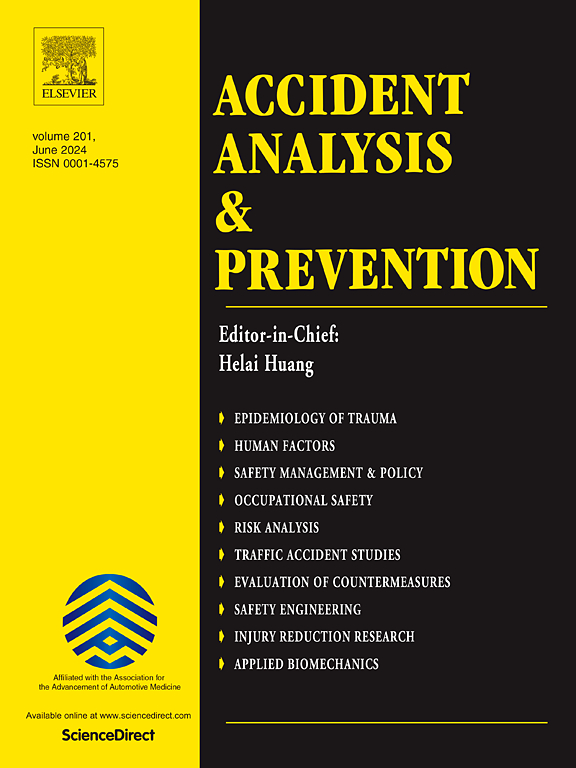探索经验丰富的高级驾驶辅助系统驾驶员的信任和行为:一项道路研究
IF 6.2
1区 工程技术
Q1 ERGONOMICS
引用次数: 0
摘要
对自动化的信任对于先进驾驶辅助系统(ADAS)的最佳利用至关重要。虽然之前的研究已经考察了对自动驾驶(TiAD)的信任及其对行为的影响,但仍有必要探索有经验的驾驶员在现实环境中如何与部分自动化系统互动。本研究调查了34名经验丰富的ADAS驾驶员在道路驾驶过程中的信任和行为,分为信任组和不信任组,包括六种典型场景。本研究评估了六种驾驶情景的初始和最终TiAD情境信任;以及行为,包括不碰方向盘、参与与驾驶无关的活动(NDRAs)和视觉行为。结果显示,驾驶前和驾驶后的TiAD没有显著变化,但在信任组和不信任组之间,TiAD和情境信任在6个场景中存在显著差异。在行为方面,信任的司机表现出更多的放手事件和对警告的延迟反应。两组人都以不同的模式进行高风险的NDRAs,而信任司机表现出更高的高风险NDRAs倾向。视觉行为分析显示,与不信任司机相比,信任司机花在监控驾驶环境上的时间更少,特别是在增加/减少车道等复杂场景中,但更多的时间集中在人机界面(HMI)上。该研究还探讨了ADAS类型和行驶里程的影响,结果表明,拥有先进功能的驾驶员表现出更高的信任度和更少的监控,而行驶里程对信任度的影响在3000公里左右出现转折点。根据这些发现,本研究强调了安全风险,并提出了解决这些风险的策略。该研究有望为信任研究和ADAS优化提供见解,提高驾驶安全和用户体验。本文章由计算机程序翻译,如有差异,请以英文原文为准。
Exploring the trust and behavior of experienced advanced driver assistance system drivers: An on-road study
Trust in automation is crucial for the optimal utilization of advanced driver assistance systems (ADAS). While previous studies have examined trust in automated driving (TiAD) and its impact on behavior, there remains a need to explore how experienced drivers interact with partially automated systems in real-world contexts. This study investigates the trust and behavior of 34 experienced ADAS drivers, divided into trustful and distrustful groups, during on-road driving encompassing six typical scenarios. This study evaluates the initial and final TiAD, situational trust across six driving scenarios; and behaviors, including hands-off the steering wheel, engagement in non-driving-related activities (NDRAs), and visual behavior. Results reveal no significant change in TiAD between pre- and post-driving evaluations, but there are significant differences in TiAD and situational trust across six scenarios between the trustful and distrustful groups. Regarding behavior, trustful drivers exhibit more hands-off events and delay responses to warnings. Both groups engage in risky NDRAs with different patterns, while trustful drivers showing a higher tendency for high-risk NDRAs. Visual behavior analysis shows that trustful drivers spend less time monitoring the driving environment, particularly in complex scenarios such as lane addition/reduction, but more time focusing on the human–machine interface (HMI) overall compared to distrustful drivers. The study also explores the impact of ADAS type and mileage, showing that drivers with advanced functionality exhibit higher trust and reduced monitoring, while mileage influence trust with a turning point at around 3,000 km. With these findings, this study highlights safety risks and proposes strategies to address them. This study is expected to provide insights into trust research and ADAS optimization, enhancing driving safety and user experience.
求助全文
通过发布文献求助,成功后即可免费获取论文全文。
去求助
来源期刊

Accident; analysis and prevention
Multiple-
CiteScore
11.90
自引率
16.90%
发文量
264
审稿时长
48 days
期刊介绍:
Accident Analysis & Prevention provides wide coverage of the general areas relating to accidental injury and damage, including the pre-injury and immediate post-injury phases. Published papers deal with medical, legal, economic, educational, behavioral, theoretical or empirical aspects of transportation accidents, as well as with accidents at other sites. Selected topics within the scope of the Journal may include: studies of human, environmental and vehicular factors influencing the occurrence, type and severity of accidents and injury; the design, implementation and evaluation of countermeasures; biomechanics of impact and human tolerance limits to injury; modelling and statistical analysis of accident data; policy, planning and decision-making in safety.
 求助内容:
求助内容: 应助结果提醒方式:
应助结果提醒方式:


